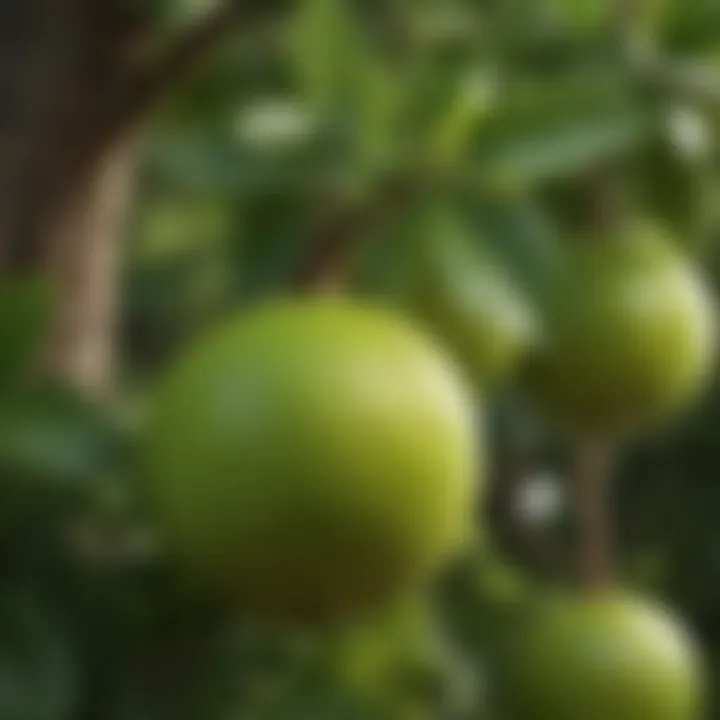Mastering Lime Tree Trimming: Techniques and Tips


Intro
Caring for lime trees goes beyond just watering and watching them grow; trimming is one of those crucial tasks that can greatly affect the health and productivity of these vibrant trees. Not only does trimming contribute to better growth and aesthetic appeal, but it also enhances fruit production. Understanding the unique requirements of lime trees allows for more effective maintenance, ensuring that they thrive in their environment.
In this exploration of trimming lime trees, we will delve into the techniques and considerations that every gardener should keep in mind. This guide aims to provide both novice and seasoned gardeners insight into the best practices for pruning lime trees, covering everything from the optimal seasons for trimming to the specific techniques that promote robust growth.
Why Prune Lime Trees?
Pruning isn't just about snipping branches away; it's a thoughtful practice that can lead to numerous benefits:
- Encourage Growth: Regular trimming encourages new growth, helping the tree to develop a strong structure.
- Improve Airflow: Removing excess branches opens up the canopy, allowing air to circulate better, which can reduce the chances of disease.
- Boost Fruit Production: A well-trimmed lime tree is less likely to be stressed, leading to healthier blooms and, subsequently, more fruit.
- Aesthetic Appeal: For many homeowners, a neatly pruned tree simply looks better in their garden or yard.
Pruning can make all the difference between a struggling tree and one that's fruit-bearing and beautiful.
Timing is Key
When it comes to trimming lime trees, timing can be the difference between a healthy tree and one that's prone to illness. The ideal time to prune these trees is just after they have produced fruit, ideally in late summer or early fall. This allows the trees to focus their energy on growth during the more favorable months ahead.
Techniques for Pruning
Now that we've established why and when to trim, let’s look at some effective techniques:
- Thinning: This involves selectively removing branches to enhance light penetration. It helps trees develop a more manageable structure.
- Sustain Healthy Growth: Always make clean cuts just above the node (the point where a leaf or branch is attached) to encourage new shoots without damaging the tree.
- Consider the Shape: Keep an eye on the overall shape of the tree, focusing on maintaining an open-center structure that allows light to reach all parts of the tree.
Season Considerations
Understanding the seasons is paramount in ensuring that your lime tree continues to prosper. Avoid heavy pruning in late winter or early spring, as trees can be more vulnerable to damage during these periods. Moreover, during winter dormancy, trees heal profound cuts more slowly. Keeping these seasonal changes in mind will guide you toward the best practices and ultimately the healthiest trees.
With our initial overview complete, we can dive deeper into specific aspects of trimming lime trees, helping you navigate your gardening journey with confidence.
Intro to Lime Trees
When it comes to cultivating lime trees, understanding the foundational characteristics and varieties is essential. Lime trees aren't just a source of zesty fruit; they also serve a vital role in landscaping and home gardening. Knowing about lime trees helps in grasping their specific needs, which can significantly impact growth and productivity.
Proper care, including trimming, ensures the longevity and vitality of these trees. In this article, we will delve into how you can keep your lime trees thriving and healthy.
Understanding Lime Tree Varieties
Lime trees come in a handful of varieties, each with unique attributes that determine their care and maintenance. The two most common types are the Persian lime, known for its juiciness, and the Key lime, which is smaller and has a more aromatic flavor. Cultivating these trees requires understanding their specific traits.
- Persian Lime (Citrus latifolia): This variety thrives in warmer regions and is often seedless. It tends to be more resistant, making it the favorite for home gardeners.
- Key Lime (Citrus aurantiifolia): More delicate and flavorful, this lime often requires care during cold spells. It’s smaller and more prone to pests, so close attention is necessary.
Choosing the right variety for your climate and gardening style lays the groundwork for successful lime cultivation.
Lime Tree Characteristics
Understanding the traits of lime trees goes beyond merely knowing their species; it involves recognizing how those traits affect their growth habits and pruning needs. Lime trees typically grow to about 10 to 20 feet tall, though they can be kept smaller by consistent trimming.
- Leaves: The leaves are dark green and glossy, signaling a healthy tree. If the leaves start to yellow, it may indicate an issue with the soil or drainage.
- Flowers: Lime trees are known for their fragrant white flowers. These blooms not only enhance the aroma of a garden but also signal the coming of fruit.
- Fruit: The fruit develops after flowering, ripening in different times depending on the variety. Key limes are smaller and often picked when they're still slightly green, while Persian limes are generally picked when fully mature.
Both understanding the variety and the specific characteristics can significantly influence your approach to trimming. It’s not just about aesthetics; know what to look for can lead you to better decision-making regarding your lime tree care.


"The key to fruitful gardening lies in understanding your plants deeply. Lime trees are no exception, as their beauty and bounty are tied to their unique needs."
By grasping these essentials, you're already on the right track in mastering the art of lime tree maintenance.
Importance of Trimming Lime Trees
Trimming lime trees is not merely an aesthetic endeavor; it plays a crucial role in ensuring their health and productivity. Homeowners, gardening enthusiasts, and anyone tending to these delightful trees should understand that a well-timed and executed trim can make a world of difference. Let’s explore some of the key reasons why trimming lime trees is essential.
Enhancing Fruit Production
One of the top reasons for trimming lime trees lies in increasing their fruit yield. When you prune, you focus on removing dead or overcrowded branches that may hinder sunlight from reaching the inner leaves. Proper light exposure is vital for photosynthesis, which is the engine of growth and fruit production. A well-pruned tree allows air to circulate better, which can reduce fruit rot and diseases.
- Encourages New Growth: Trimming stimulates new growth by allowing younger branches to flourish, which often leads to more fruit-bearing limbs.
- Rejuvenates Old Trees: In older trees, selective pruning can reinvigorate the plant, ultimately leading to a more bountiful harvest.
- Improves Quality: Controlled pruning not only boosts quantity but also improves the quality of the limes, making them juicier and more robust in flavor.
Promoting Healthy Growth
Healthy growth is something every gardener aspires to, and trimming is a significant factor in achieving this. By regularly assessing your lime tree’s needs and trimming accordingly, you prevent several problems that can arise from neglect.
- Removes Diseased Wood: Getting rid of branches affected by pests or diseases helps protect the healthy portions of the tree. A careful inspection after trimming lets you catch any issues early on.
- Encourages Strong Structure: Frequent pruning leads to a more balanced tree shape, which can support more robust limbs, thereby reducing the risk of breaking under the weight of the fruit.
- Prevents Overcrowding: Trees that are too dense can compete for resources and sunlight, leading to stunted growth. Trimming helps alleviate this competition, allowing the tree to thrive.
Maintaining Aesthetics and Shape
While functionality is essential, we can’t overlook the visual appeal of a well-maintained lime tree. Trimming helps keep the tree looking neat and attractive, which is especially important for homeowners who might use these trees for decoration or fruit purposes alike.
- Defines Shape: A carefully shaped lime tree can be a stunning centerpiece in your garden. Pruning can turn a wild-looking tree into a beautifully structured asset that enhances the overall landscape.
- Controls Size: Keeping your lime tree at an appropriate size means easier maintenance and access for harvesting fruit or performing routine inspections for pests.
- Seasonal Beauty: Many lime trees blossom and fruit at different times of the year. Regular trimming ensures that whatever the season, your tree remains a beautiful sight.
"A balanced approach to trimming not only promotes the health and productivity of lime trees, but it also elevates the aesthetic of any garden space."
In summary, trimming lime trees is more than a simple chore; it’s a practice that nurtures their health, promotes productivity, and maintains beauty. The next section will delve into the optimal timing for trimming and the signs that indicate it is needed.
Best Time to Trim Lime Trees
Timing matters a lot when it comes to maintaining your lime trees. Knowing the right time to prune can make all the difference between a flourishing tree and one that struggles to produce fruit. Seasonal changes impact not only the tree's health but also the growth patterns, meaning that choosing the optimal time can enhance productivity and aesthetics.
Factors Affecting the Timing of Pruning:
Several elements should be on your radar when determining when to trim. These include the local climate, tree age, and the specific lime tree variety in your garden. In general, pruning during the right season reduces stress on the tree and helps in quicker recovery.
Seasonal Pruning Considerations
Pruning lime trees is not a one-size-fits-all affair. Different seasons come with their own set of considerations. The best practice is to keep an eye on both the calendar and the tree's growth patterns.
- Spring: Early spring is usually the most favorable time for pruning lime trees. This is when the tree is coming out of dormancy and is gearing up for new growth. Removing any dead or damaged branches helps in redirecting nutrients to healthier parts of the tree.
- Summer: Light pruning in summer can also be effective for maintaining shape and removing suckers, but heavy pruning is best avoided as it can result in shock.
- Fall: During fall, trees start preparing for winter. Heavy pruning at this time could leave your tree exposed to damage from cold weather. However, if you see some dead wood, it's ok to remove it.
- Winter: In regions with milder winters, you might consider pruning before the frost, while in areas with harsher winters, it’s best to wait until temperatures warm up, ideally into March.
Signs That Indicate Pruning is Needed
Your lime trees will often send you signals about when they require a bit of work. Learning to spot these signs is crucial for effective maintenance.
- Overcrowded Branches: If branches are competing for space, it’s time to trim. An overcrowded tree may not get enough sunlight, affecting its overall health.
- Dead or Damaged Limbs: Keep an eye out for branches that are dead, discolored, or showing signs of disease. Removing these can help prevent further issues.
- Unhealthy Growth Patterns: If you see that the tree has started to grow asymmetrically or is leaning, some strategic cuts can help restore balance.
- Reduced Fruit Production: If you’ve noticed fewer limes than usual, it might be time to give your tree a refresh. Pruning encourages growth, which, in turn, leads to increased fruiting.
"Timely intervention can indeed be the key that unlocks a tree’s potential."
By understanding these considerations and the signs your lime tree exhibits, you’re setting the stage for optimal health and productivity. The importance of the right timing cannot be overstated, and a well-timed prune can steer your lime tree towards a future rich in fruit and lush foliage.


Pruning Techniques for Lime Trees
Pruning techniques are not just a refined skill but a fundamental practice for anyone interested in cultivating vibrant and fruitful lime trees. Understanding how to approach trimming gives you the power to enhance tree health and improve fruit yield. Whether you're an experienced gardener or just starting, your approach to pruning will have significant implications not only for the tree's growth but also for its overall viability. This section will explore essential tools, a step-by-step guide, and common pitfalls, equipping you with the knowledge you need to thrive.
Tools Required for Trimming
Before you wield your shears, it's crucial to gather the right tools to ensure a successful pruning session. Using the correct equipment can make a world of difference in how your lime trees respond to trimming. Here's a rundown:
- Pruning Shears - High-quality bypass pruning shears are your best friend. They provide clean cuts, which are less likely to harm the tree.
- Loppers - For larger branches, loppers can reach higher, enabling you to tackle those out-of-reach areas with ease.
- Hand Saw - In cases where limbs are too thick for shears or loppers, a hand saw becomes essential.
- Gloves - Protect your hands from thorns and other hazards in your lime tree's vicinity.
- Ladder - A sturdy ladder allows you to access those upper branches without putting yourself at risk.
- Disinfectant - Keeping your tools clean between trees is key to preventing disease transmission.
Using these tools properly will pave the way for effective pruning.
Step-by-Step Pruning Process
Taking your time during the pruning process can elevate the health and productivity of your lime tree. Follow these steps for a thorough and effective procedure:
- Assess the Tree - Begin with a careful inspection. Look for branches that are dead, diseased, or crossing one another.
- Start with Dead or Diseased Wood - Remove any parts that show signs of infection to keep the tree healthy.
- Thin Out Crowded Branches - Open up the canopy by selectively removing interior branches that hinder air circulation and light penetration.
- Shape the Tree - Maintain an open and balanced structure. You want your tree to have a pleasing form while allowing sunlight to reach all areas.
- Cut at the Right Angle - Always cut at a slight angle to allow rainwater to run off, preventing disease buildup on the cuts.
- Make Cuts Just Outside the Collar - The collar is a swollen area of the branch at the point where it meets the trunk. Cutting here encourages healing.
- Inspect Your Work - After pruning, stand back and take a look. Ensure you've maintained a balanced shape and removed unnecessary weight.
"Good pruning is a balance of art and science, creating a masterpiece that bears fruit in more ways than one."
Avoiding Common Pruning Mistakes
Even seasoned gardeners can stumble during the pruning process. Awareness of common pitfalls can save you from heartache:
- Over-Pruning: Avoid cutting too much; this can leave the tree stressed.
- Ignoring Tree Variety: Different lime tree varieties might have specific requirements. Familiarize yourself with the one you're tending to.
- Poor Timing: Pruning at the wrong time can hinder growth. Stick to optimal periods discussed earlier.
- Neglecting Tool Maintenance: Dull tools lead to jagged cuts. Ensure your tools are sharp before starting.
- Pruning When Wet: Wet conditions increase the risk of spreading disease. Wait for dry conditions.
By avoiding these common mistakes, you'll engage in a more effective and health-promoting pruning process.
Post-Pruning Care for Lime Trees
Taking care of your lime trees after pruning is crucial. This stage can differentiate between merely maintaining your tree and optimizing its growth and fruit production. When you prune a lime tree, you’re not just cutting branches away. You’re also creating an opportunity for the tree to focus its energy on new growth and fruiting.
Post-pruning care is like a follow-up appointment for your tree. It ensures that the tree has all it needs to recover and thrive after the intervention. Below are the key aspects you should focus on:
- Watering
- Fertilization
- Monitoring tree health
Each of these elements plays a vital role in ensuring your lime trees bounce back after trimming, preventing stress and promoting robust growth.
Watering After Pruning
After you’ve trimmed your lime tree, it’s important to provide it with adequate hydration. The tree has gone through a significant change, and watering helps alleviate stress. However, timing and method matter a lot.
- Immediate watering: Right after pruning, give your tree a good soaking. This encourages roots to rejuvenate.
- Keeping the moisture steady: For about two weeks after pruning, make sure the soil stays moist but not soggy. This balance helps the tree absorb sufficient nutrients and promotes new growth.
- Avoiding overwatering: Keep an eye on drainage. Soggy roots can lead to diseases, which no gardener wants to deal with.
Regularly check the soil. If the top inch feels dry, it's time for another drink. Remember, every tree's needs can change with weather and other conditions.
Fertilization Guidelines
Fertilizing after pruning can give your lime tree a much-needed boost. The nutrients encourage new shoots, leaves, and eventually fruit. However, not all fertilizers are created equal, and timing is essential.
- Follow-up fertilization: Wait about a month post-pruning before applying fertilizer. This gives the tree time to recover before introducing new nutrients.
- Choosing the right fertilizer: Go for a balanced, slow-release fertilizer, ideally one formulated for citrus or fruit trees. Look for fertilizers that contain nitrogen, phosphorus, and potassium, as these are key elements for vigorous growth.
- Application method: Spread the fertilizer evenly around the tree's base, avoiding the trunk directly. Water it in well to assist absorption.


"A well-fed tree is like a well-nourished child; both will grow strong and healthy."
Monitoring Tree Health
Once you've completed the watering and fertilization processes, you can't just sit back and relax. Keeping an eye on your lime tree's health is imperative. Regular checks will help you catch any problems early on.
- Check for pests: Inspect the leaves and branches for any signs of infestations. Scale insects or aphids can appear, especially after you've pruned and stressed the tree.
- Observe new growth: Healthy lime trees should begin to sprout fresh leaves within a few weeks of pruning. If you don't see healthy growth forming, further investigations may be necessary.
- Watch for disease symptoms: Yellowing leaves or unusual leaf drop can indicate issues. If you start seeing such symptoms, research appropriate treatments immediately.
By regularly monitoring the tree, you can intervene quickly and ensure your lime tree remains healthy, robust, and ready to produce delicious limes.
Troubleshooting Common Issues
When caring for lime trees, being proactive about potential problems can save time, money, and effort down the line. As any seasoned gardener will tell you, issues can crop up unexpectedly, and knowing how to handle them is crucial. The health of your lime tree is impacted by a myriad of factors, including pests, diseases, and the repercussions of pruning techniques. Without a good handle on how to troubleshoot these issues, your investment in time and resources could go down the drain.
In this section, we will delve into two primary considerations: identifying common pests and diseases and understanding the impact of incorrect pruning techniques. Recognizing these elements early on can not only rescue your lime tree but also help you maintain a thriving garden.
Identifying Pests and Diseases
One of the most significant threats to lime trees are pests. Pests such as aphids, spider mites, and whiteflies can wreak havoc on your lime tree's health. These tiny invaders feed on the sap, weakening your tree and impacting fruit yield. Here’s how to spot them:
- Aphids: Small, pear-shaped insects that cluster on the new growth and undersides of leaves. Look for curling leaves and sticky residues or honeydew left behind.
- Spider Mites: Often mistaken for dust, these pests create fine webbing and cause yellowing of leaves. A quick way to check is to shake affected branches over a white sheet. If you see tiny specks moving, you've got mites.
- Whiteflies: Small white-winged insects flying near the plant. These pests also leave honeydew and can lead to sooty mold.
To manage these pests, a mix of natural remedies, like using neem oil or introducing beneficial insects, can be effective. It’s essential to inspect your lime trees regularly, especially after heavy rains or droughts, as these conditions may bring about infestations.
Diseases can also plague your lime trees, often rooted in improper care or environmental stress. Common diseases include:
- Citrus Canker: Characterized by raised, blemished spots on leaves and fruit. It can spread quickly, so make sure to isolate affected trees immediately.
- Phytophthora Root Rot: A fungal disease that causes yellowing leaves and stunted growth. After checking the roots, a healthy portion should be firm and white. Decayed roots will appear dark and mushy.
- Powdery Mildew: This fungal infection appears as a white powder on leaves. It thrives in warm, dry conditions and can be treated with fungicidal sprays or organic solutions.
Remember: It's always easier to prevent than to cure. Keeping your tree healthy through proper watering, fertilization, and sunlight exposure can significantly reduce the risk of pests and diseases.
Impact of Incorrect Pruning Techniques
Pruning is not simply about aesthetics; it’s about the overall health and productivity of your lime tree. Incorrect techniques can lead to stunted growth, reduced fruit yield, or even long-term damage to the tree. Here’s how you might misstep:
- Over-pruning: Too much removal of foliage or branches can shock the tree. Lime trees rely on their leaves for photosynthesis, and taking away too many leaves limits this process.
- Bad Timing: Pruning during a tree’s active growth or late in the blooming season can lead to cuts that don't heal properly. Ideally, prune when the tree is dormant to minimize stress.
- Wrong Angle Cuts: Making cuts at improper angles can prevent the tree from healing. Always ensure your cuts are clean and angled correctly.
It’s critical to educate oneself on the proper techniques before grabbing those pruning shears. Take time to consider the following:
- Know your tree’s growth habits. Different lime species may require varied approaches.
- Use sharp, clean tools to ensure smooth cuts that prevent infections.
- Research and follow a structured guide tailored to lime trees, especially if you’re unsure about the process.
By concentrating on effective identification of pests and diseases and understanding correct pruning methods, you will foster a healthier lime tree. This focus will ultimately lead to better growth and production, allowing you to enjoy the fruits of your labor, literaly and figuratively.
Closure
Pruning lime trees isn’t just a mundane chore; it’s a fundamental part of maintaining the health and vitality of these delightful plants. As we’ve explored throughout this article, the process encompasses several critical aspects that contribute to the thriving of lime trees. From increasing fruit yields to shaping the financial landscape of your garden, every snip matters.
Summary of Key Takeaways
- Enhanced Fruit Production: Pruning lime trees correctly can significantly boost fruit output. By removing crowded branches, you allow more sunlight to penetrate, facilitating better flower development.
- Healthy Growth Promotion: Regular maintenance keeps your lime trees in robust health, ensuring they don’t fall prey to pests or diseases, which can spread rapidly in neglected foliage.
- Aesthetic Appeal: A well-trimmed lime tree adds beauty to your garden, providing an entrance to a world of lush foliage and vibrant fruit.
- Seasonal Awareness: Understanding the right time to prune and recognize signs for necessary cuts ensures you are not just randomly making snips. Timing is key.
Final Thoughts on Lime Tree Maintenance
In summary, lime tree maintenance wraps up a holistic approach beyond just trimming. It’s about creating an environment where these trees can flourish. This means keeping an eye on their health after pruning, ensuring they are watered properly and nourished with good fertilizers. Knowledge is power, especially when tackling pruning techniques, seasonal changes, and post-care routines.
As any seasoned gardener can tell you, gardening is a journey. It requires patience, attention to detail, and a bit of intuition. The next time you step into your garden, take a moment to observe your lime trees. Listen to what they might be telling you, and apply what you have learned in this article. After all, they are not just trees—they are a testament to your hard work and dedication.
"Gardening is the purest of human pleasures." - Frances Mayes
In cultivating our trees with care, we find joy in the process and a flourishing garden that rewards us with an abundance of lime zest and luscious flavors.



